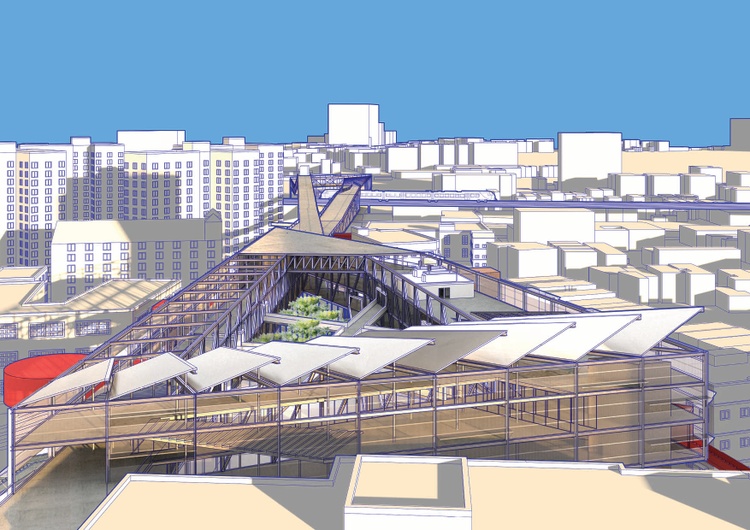Changing Spaces: The Vision of CDA Architects for Modern Living
Changing Spaces: The Vision of CDA Architects for Modern Living
Blog Article
A Thorough Summary of Building Designs and Their Impact on Modern City Preparation and Development
Architectural designs have actually long offered as a mirror to the social worths and technological improvements of their time, playing an important duty in forming modern-day city planning and advancement. From the majesty of Neoclassicism to the utilitarian approach of Brutalism, each design has actually presented unique ideas that affect city aesthetics and capability.
Historical Introduction of Architectural Styles

As societies transitioned through the Center Ages, Gothic architecture emerged, characterized by its verticality and complex outlining, mirroring the spiritual aspirations of the age. The Renaissance noted a revival of timeless perfects, merging art and style in innovative means that affected subsequent designs across Europe.

Today, architectural designs continue to advance, driven by globalization and sustainability concerns, mirroring a vibrant interaction between heritage and development. This historic introduction emphasizes the significance of architecture as a mirror of societal evolution and as a catalyst for urban development.
Secret Architectural Styles Explained
The variety of architectural styles shows the myriad influences that shape our developed setting, each symbolizing distinctive attributes and social values. Key building designs include Classical, Gothic, Baroque, Innovation, and Postmodernism, each standing for unique historical contexts and visual approaches.
Timeless design, rooted in old Greece and Rome, emphasizes symmetry, proportion, and making use of columns (cda architects). On the other hand, Gothic style, thriving between Ages, is defined by pointed arches, ribbed vaults, and flying buttresses, developing a heavenly high quality in cathedrals. Baroque design, emerging in the 17th century, is noted by splendour, sophisticated ornamentation, and a dynamic interplay of light and darkness
Modernism, which acquired momentum in the early 20th century, prioritizes feature over kind, using new materials like steel and glass to create minimal frameworks. Postmodernism, responding versus the austerity of Innovation, accepts eclecticism and historic reference, typically incorporating playful components and irony.

Effect On Urban Preparation
In shaping the growth of cities, architectural styles dramatically affect metropolitan preparation choices. The choice of building style frequently determines the visual appeals, helpful site performance, and overall personality of city atmospheres. Innovation, with its emphasis on minimalism and functionality, motivates open areas and the combination of innovation, shaping city formats that focus on performance and ease of access. Conversely, typical designs might highlight historic preservation, bring about metropolitan designs that preserve social heritage and promote pedestrian-friendly atmospheres.
Furthermore, architectural designs can influence zoning laws and land use policies. Urban organizers should take into consideration the dominating building patterns when creating areas, guaranteeing that new advancements balance with existing frameworks. This factor to consider fosters cohesive urban landscapes and enhances community identity.
The execution of specific building styles can likewise affect socioeconomic aspects within a city. For instance, premium modern designs might attract upscale homeowners and companies, causing gentrification, while much more inexpensive housing remedies could focus on sensible and sustainable styles to suit diverse populations. Inevitably, the interplay between architectural designs and metropolitan preparation creates dynamic cities that show both historic context and modern needs, forming the lived experiences of their citizens
Sustainability and Modern Style
Architectural styles play a critical duty in resolving modern challenges, particularly in More hints the realm of sustainability. As metropolitan locations broaden and environmental concerns increase, contemporary architecture increasingly welcomes lasting style concepts that focus on energy efficiency, source conservation, and marginal ecological influence.
Contemporary building activities, such as biophilic design and environment-friendly style, supporter for frameworks that integrate with their environments, utilizing all-natural materials and promoting biodiversity. These styles usually include renewable resource sources, such as photovoltaic panels and wind generators, to decrease reliance on nonrenewable fuel sources and reduced carbon impacts.
Additionally, the combination of sophisticated innovations, such as clever building systems, improves energy management, enhancing resource use while making certain owner convenience. Cutting-edge water administration approaches, including rainwater harvesting and greywater recycling, more add to sustainable metropolitan settings.
Significantly, sustainability expands beyond ecological issues; it includes social and financial dimensions. By fostering neighborhood wellness and promoting inclusivity, contemporary building styles line up with sustainable development objectives. The evolution of architectural methods continues to form resilient cities that not only satisfy the requirements of the present yet also secure the future for generations to come.
Area Engagement in Style
Neighborhood involvement in layout acts as an essential bridge in between designers and the populaces they serve, guaranteeing that the built atmosphere mirrors the demands and aspirations of its customers. This collective procedure invites area members to contribute their understandings and preferences, cultivating a sense of next page ownership and obligation toward the areas they occupy.
Effective area interaction utilizes various approaches, such as workshops, surveys, and public online forums, to gather diverse point of views. These techniques assist in a two-way dialogue, enabling engineers to recognize neighborhood contexts while equipping citizens to voice their problems and desires. This inclusivity not just boosts the design high quality yet additionally promotes social equity by dealing with the special obstacles dealt with by marginalized teams.
Furthermore, area interaction can cause cutting-edge options that might not emerge in a conventional layout procedure. By integrating regional expertise and social worths, designers can create rooms that reverberate even more deeply with users, boosting functionality and sustainability. Inevitably, focusing on community interaction in style processes results in environments that nurture social communications, assistance well-being, and reinforce neighborhood connections, consequently playing a critical duty fit contemporary city landscapes.
Final Thought
Architectural styles have actually greatly influenced modern city planning and advancement, reflecting progressing social and technical contexts. As cities proceed to grow and adapt, the continuous discussion between architectural heritage and modern layout concepts will certainly continue to be necessary in developing comprehensive, dynamic areas that boost quality of life and advertise social equity.
Report this page